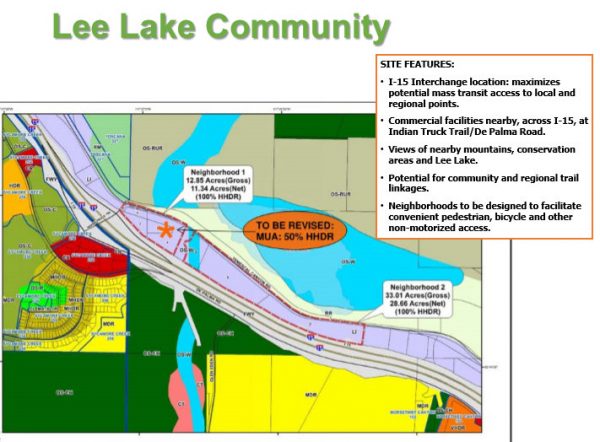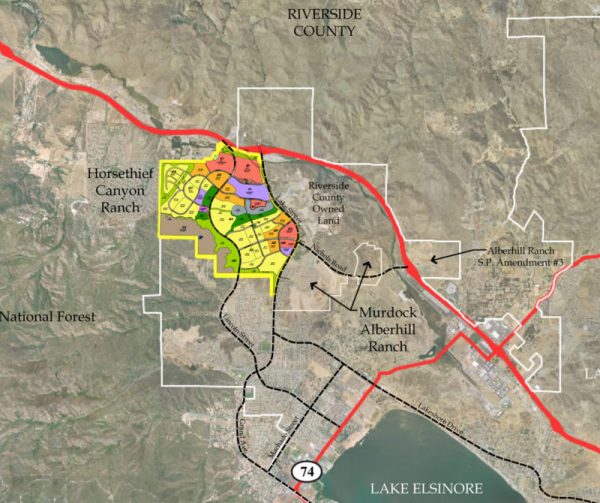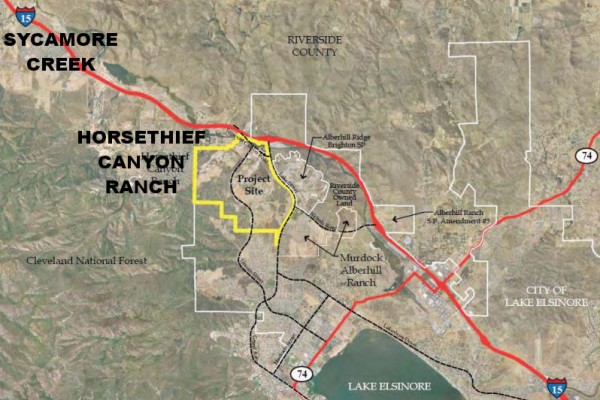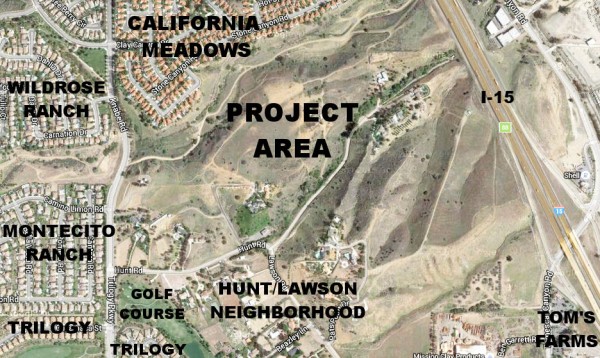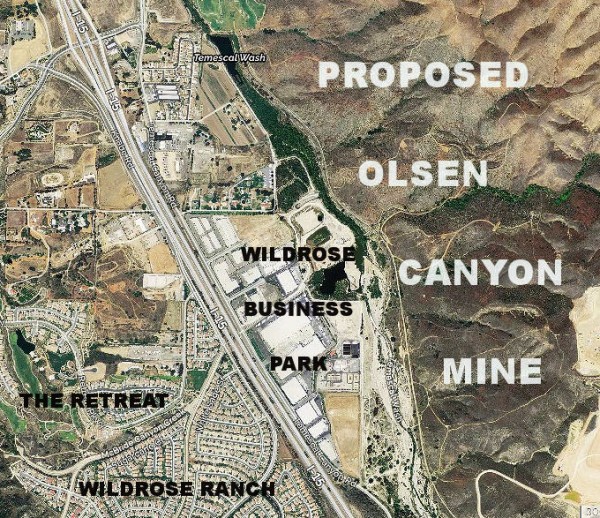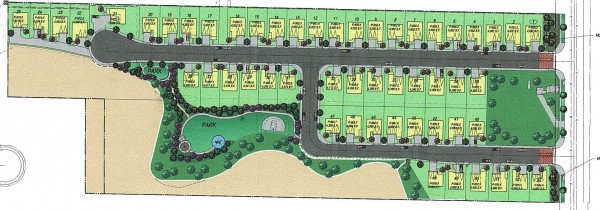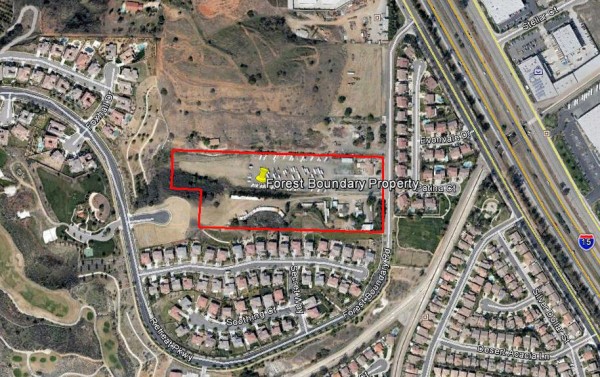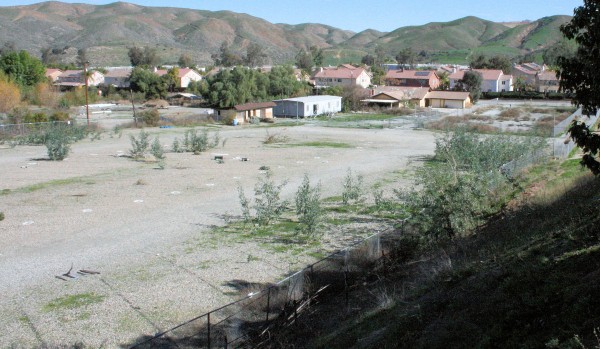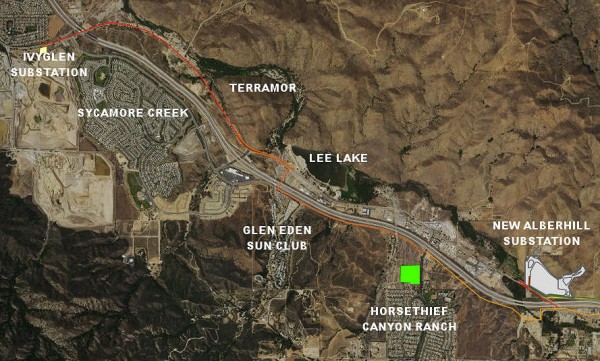
The orange line depicts the path of the Valley-IvyGlen transmission lines. The lines will run above ground and cross the freeway north of Glen Eden, continue north to about Indian Truck Trail where they will be placed underground. The proposed 34-acre Alberhill substation is pictured on the right.
Here’s what next for SCE’s Alberhill substation project
(Published Dec. 14, 2018)
In its quest to prove to the California Public Utilities Commission (CPUC), the need for another substation in the area, Southern California Edison last month asked for public comments suggesting alternatives to the Alberhill substation it plans to build in Temescal Valley. A Nov. 30 deadline was set for receipt of comments.
The We Are Temescal Valley Development Committee has taken a stand against the 34-acre Alberhill substation and its two 500-kV transmission lines and towers being located here. The committee urged residents to suggest an alternative location in the vicinity of Walker Canyon Road and Hill Top Drive, north of the I-15 in an unincorporated county area. The committee also recommended the use of battery storage technology.
Many residents complied with the request and sent comments to Edison. So, what are the next steps?
- January-February 2019: Public invited to participate in an online “webinar.”
- March-June 2019: SCE will present its assessment of new alternatives at an open house.
- June-September 2019: Another public webinar planned. SCE will present its final data items submitted to the CPUC.
- Fourth quarter 2019: The public can participate in any California Environmental Quality Act (CEQA), process led by the CPUC.
Alberhill alternative comments to Edison are due Nov. 30
(Published Nov. 21, 2018)
The California Public Utilities Commission (CPUC) has sent Southern California Edison back to the drawing board in the utility’s quest to get approval for its proposed Alberhill substation.
At the Aug. 23 CPUC meeting, SCE’s 115-kV Valley-IvyGlen subtransmission lines were approved, but no decision was rendered on the Alberhill substation proposal. Both projects are in Temescal Valley.
Commissioners left the Alberhill project open, instructing SCE to provide new evidence indicating a need for the substation based on more reliable projections of electrical demand.
SCE held two workshops earlier this month to update ratepayers in the affected communities. In the CPUC’s final decision, there are nine areas identified for additional analyses by the utility. One of the areas is a cost/benefit analysis of several alternatives and SCE is asking the public’s assistance in identifying alternatives.
At the workshops, SCE representatives said that system alternatives must enhance the reliability of the Valley South System that has no tie-in to another system for backup and provide additional capacity – both being the intent of the Alberhill project. Suggested alternatives should evaluate energy storage, distributed energy resources, demand response and smart grid solutions.
The We Are Temescal Valley Development Committee has taken a stand against the Alberhill substation and its 500-kV transmission lines and towers being located here. The committee is suggesting an alternative location in the vicinity of Walker Canyon Road and Hill Top Drive, north of the I-15 in an unincorporated county area. The committee also recommends the use of battery storage technology.
SCE has set a Friday, Nov. 30 deadline for suggested alternatives. It’s important that Temescal Valley residents respond. If you don’t want to compose an email in your own words, there’s a “cheat sheet” below. Just follow the instructions – copy and paste into an email program and send it to ASP@sce.com.
Here’s the CPUC Decision
Here’s the SCE Workshop Presentation
___________________________________________________________________________________________________
SUGGESTED PUBLIC COMMENT TO SEND TO SCE
COPY TEXT BELOW AND PASTE INTO AN EMAIL WINDOW
SUBJECT LINE: ALBERHILL SYSTEM PROJECT
DON’T FORGET TO ADD YOUR NAME AT THE BOTTOM
EMAIL TO ASP@sce.com
DEADLINE IS FRIDAY, NOV. 30
Re: New Alternatives to Alberhill System Project following public workshop
As a resident of the Temescal Valley, I support the need for a substation that would provide power resources for future development. While the Alberhill Substation fell short of meeting the Temescal Valley needs, the following recommendations to the Alberhill System Project would be supported by many Temescal Valley residents.
The site for the formerly proposed Alberhill System Project substation should be relocated to a location at Walker Canyon Road and Hill Top Drive, north of the Interstate 15 Freeway in unincorporated Riverside County. The rationale for this location is as follows.
1. This substation location would not negatively impact current and future residential and commercial property development and their property values.
2. This substation location would be easily accessible by Southern California Edison during severe weather conditions.
3. This substation location would allow for connection to the Valley-Serrano 500 kV transmission line.
4. The design of the substation should incorporate maximum screening elements including an aesthetic building façade and landscaping to mitigate any negative aesthetic impacts to future residential, commercial and industrial development.
5. The substation could be developed in two phases. In phase I the substation would be developed to meet peak energy needs with the installation of batteries. In phase II the substation would be fully developed per the original Alberhill Substation design to meet the needs of new residential, commercial and industrial development.
It is believed that locating the substation at Walker Canyon Road and Hill Top Drive, north of the Interstate 15 Freeway in unincorporated Riverside County would have community support. The community (residential, commercial & industrial) needs safe and reliable power resources to facilitate the future growth within the Valley South System.
It is imperative that the approval of new substation location identified above be fast-tracked and development undertaken to meet the increased power resource needs in the next five years.
Thank you,
Temescal Valley, CA 92883
_________________________________________________________________________________________________
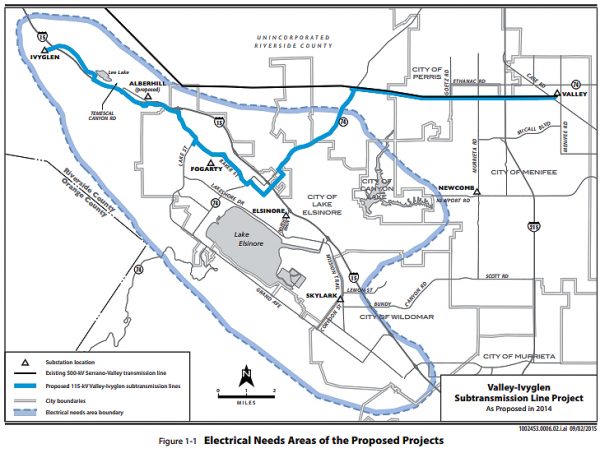
VALLEY-IVYGLEN 115-kV SUBTRANSMISSION LINE PROJECT: The route of the line is depicted in dark blue. It starts at the Valley substation in Menifee, runs through Perris and Lake Elsinore, and continues into Temescal Valley, ending at the IvyGlen substation on Temescal Canyon Road. The light blue outline depicts the area to be serviced by the subtransmission line.
CPUC rules on Edison projects
(Published Sept. 14, 2018)
After five postponements dating back to May, the California Public Utilities Commission (CPUC), on Aug. 23 approved Southern California Edison’s 115-kV Valley-IvyGlen subtransmission lines but denied the utility’s Alberhill substation proposal.
The decision followed closely the recommendation of Hallie Yacknin, CPUC administrative law judge, who after reviewing the final environmental impact report for the two projects, issued a proposed decision to approve the Valley-IvyGlen lines and to deny the Alberhill substation.
Yacknin, in the 104-page decision released in April, ruled the need for the Valley-IvyGlen lines as a backup power source outweighed the environmental impacts on noise and air quality the project will have during construction, as well as “its significant and unavoidable cumulative impacts on air quality and biological resources.”
Yacknin’s decision for the Alberhill project was based on her belief that SCE had overstated the need for the substation based on the utility’s forecast of increased electric demand in the area. Yacknin reasoned that because it was unlikely the $464 million project will be needed, “at all or in any case by 2021, we do not find overriding considerations that merit approval.” The cost of the project would have been passed onto ratepayers.
In rendering the final decision, the CPUC ordered SCE to provide new evidence indicating a need for the substation based on more reliable projections of electrical demand. The project was left open so if new evidence is presented and found acceptable by the CPUC, the substation could be built.
Edison has spent 11 years working on the two projects – both located in Temescal Valley.
Valley-IvyGlen calls for 27 miles of single-circuit 115-kV subtransmission lines to run from the Valley substation in Menifee, through Perris and Lake Elsinore, and continue into Temescal Valley, running north along De Palma Road adjacent to Horsethief Canyon Ranch and Glen Eden Sun Club.
The above-ground lines will cross to the east side of the 1-15 north of Glen Eden and continue along Temescal Canyon Road. They will be placed underground at about Indian Truck Trail, where they will continue to the IvyGlen substation on Temescal Canyon Road near Maitri Road. Temescal Valley residents opposing the project wanted all the lines underground.
The 34-acre Alberhill substation would have been constructed on 124 acres of land owned by Edison at the corner of Temescal Canyon and Concordia Ranch roads east of the 1-15 and across the freeway from the 1,900-home Horsethief Canyon Ranch neighborhood.
Edison projects slated for Aug. 23 CPUC meeting
(Published Aug. 17, 2018)
The California Public Utilities Commission could render its final decision on the 115-kV Valley-IvyGlen subtransmission lines and the Alberhill substation at a 9:30 a.m. meeting, Thursday, Aug. 23 at CPUC headquarters in San Francisco.
The Edison projects appeared on CPUC agendas for meetings to be held May 10, and 31, June 21, July 12 and Aug. 9 but were postponed for additional review.
CPUC judge says ‘yes’ to SCE line; ‘no’ to substation
(Published April 12, 2018 and updated May 5, 2018)
Hallie Yacknin, an administrative law judge with the California Public Utilities Commission, has reviewed the final environmental impact report for two Southern California Edison projects and issued a proposed decision to approve the 115-kV Valley-IvyGlen subtransmission lines and to deny the Alberhill substation.
With the proposed decision announced, the CPUC could render a final decision at a 9:30 a.m., Thursday, May 10 meeting to be held at Fontana City Hall, 8353 Sierra Ave. General comments from the public will be allowed during the meeting. Comments also can be emailed to: Public.Advisor@cpuc.ca.gov. Reference agenda item No. 14 and Proceeding 07-01-031.
Yacknin, in the 104-page decision dated April 4, ruled the need for the Valley-IvyGlen lines as a backup power source outweighs the environmental impacts on noise and air quality the project will have during construction, as well as “its significant and unavoidable cumulative impacts on air quality and biological resources.”
Yacknin’s decision regarding the Alberhill project was based on her belief that Edison had overstated the need for the substation based on the utility’s forecast of increased electric demand in the area. Yacknin reasoned that because it was unlikely the $464 million project will be needed, “at all or in any case by 2021, we do not find overriding considerations that merit approval.”
Edison is expected to appeal the decision’s Alberhill ruling.
The decision also noted the project would have “significant and unavoidable” impacts on aesthetics during and after construction because the structure and its transmission lines would be visible from the I-15, a scenic highway corridor, “substantially degrading the natural and rural visual character, vividness, intactness, and visual unity in the area.”
Edison has spent almost 11 years working on the two projects.
Valley-IvyGlen calls for 27 miles of single-circuit 115-kV subtransmission lines to run from the Valley substation in Menifee, through Perris and Lake Elsinore, and continue into Temescal Valley, running north along De Palma Road adjacent to Horsethief Canyon Ranch and Glen Eden Sun Club.
The lines would cross to the east side of the 1-15 north of Glen Eden and continue along Temescal Canyon Road. They would be placed underground at about Indian Truck Trail, where they will continue to the IvyGlen substation on Temescal Canyon Road near Maitri Road. Temescal Valley residents opposing the project want all the lines underground.
The proposed 34-acre Alberhill substation would be constructed on 124 acres of land owned by Edison at the corner of Temescal Canyon and Concordia Ranch roads east of the 1-15 and close to the 1,900-home Horsethief Canyon Ranch neighborhood.
The project calls for two 500-kV transmission lines to join the existing 500-kV Serrano-Valley line near the Lake Mathews-Estelle Mountain Reserve in Temescal Valley.
Read the decision:
https://www.wearetv.org/blog/docs/decision.pdf
Final EIR for Edison projects released
(Updated April 12, 2017)
The final environmental impact report for the proposed Edison powerlines and susbstation projects has been released by the California Public Utilities Commission.
It now is being reviewed or will be reviewed by an appointed Administrative Law Judge who will provide his/her proposed decision on the projects.
After the proposed decision is announced, a date and place will be set for a hearing to determine the final decision by the CPUC. This hearing will be the final opportunity for the public to offer comments on the projects.
Edison has spent more than 10 years working on the Valley-IvyGlen powerlines and the proposed Alberhill substation projects.
Valley-IvyGlen calls for 27 miles of single-circuit 115-kV subtransmission lines to run from the Valley substation in Menifee through Perris and Lake Elsinore, and continue into Temescal Valley, ending at the IvyGlen substation on Temescal Canyon Road. People protesting the project want all the lines underground.
The proposed 34-acre Alberhill substation would be constructed on 124 acres of land owned by Edison at the corner of Temescal Canyon and Concordia Ranch roads east of the 1-15 and close to the 1,900-home Horsethief Canyon Ranch neighborhood. HCR residents want the substation located elsewhere.
A significant finding in the final EIR was that none of the alternatives listed in the Draft EIR are considered environmentally superior to the proposed projects.
FINAL EIR: http://www.cpuc.ca.gov/environment/info/ene/alberhill/Alberhill.html
____________________________________________________________________________________________________________
(Updated July 17, 2016)
Thank you to everyone who signed petitions and sent emails to the California Public Utilities Commission regarding the draft environmental impact report for the Valley-IvyGlen subtransmission line and the Alberhill substation.
Comments on the Draft EIR will be addressed in a Response to Comments document that, together with the Draft EIR, will constitute the Final EIR. The Final EIR will likely be completed by late September or early October. The CPUC will issue separate proposed decisions on SCE’s applications for the proposed Valley–Ivyglen Project and the proposed Alberhill Project.
(Updated July 10, 2016)
Send your email now to: VIG.ASP@ene.com
Deadline is Friday, July 15
(Suggested wording — include your name and address)
In regards to the Valley-IvyGlen 115-kV transmission line, I SUPPORT VIG Alternative M to underground the line along the entire proposed project alignment.
In regards to the location of a substation in Temescal Valley, I OPPOSE both the Serrano and Alberhill locations. Additional research must be undertaken to find a location suitable to the majority of Temescal Valley residents, land owners and businesses.

The orange line depicts the path of the Valley-IvyGlen transmission lines. The lines will run above ground and cross the freeway north of Glen Eden, continue north to about Indian Truck Trail where they will be placed underground. The proposed 34-acre Alberhill substation is pictured on the right.
Public Utilities Commission extends deadline to July 15
(Updated May 31, 2016)
The California Public Utilities Commission has extended the deadline for the public comments period to July 15. Comments on the draft environmental impact report for Southern California Edison’s Valley-IvyGlen project and the proposed Alberhill substation can be emailed to: VIG.ASP@ene.com
Related Press-Enterprise report:
More time granted for power project comments
Draft EIR sets forth alternatives for the project
(Updated May, 11, 2016)
Alternative proposals in the draft environmental impact report were included based on public concerns during the scoping period last year. The CPUC then analyzed the alternatives to determine if they reduced at least one environmental impact of the proposed project.
For a better understanding of the alternatives, view the Draft Environmental Impact Report at: http://www.cpuc.ca.gov/Environment/info/ene/ivyglen/ IvyglenDraftEIR.html
Click on 3.0 Description of Alternatives and 5.0 Comparison of Alternatives
Viable alternatives to the Valley-IvyGlen (VIG), transmission line include VIG Alternative M that would require the entire proposed project line to be undergrounded.
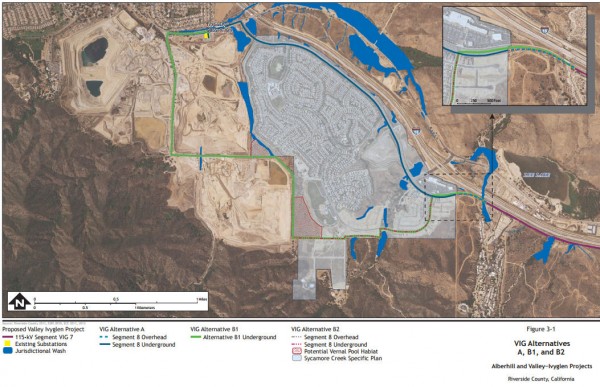 VIG Alternative A would alleviate the necessity for the line to cross the I-15 by extending it north from Glen Eden for another 2,000 feet. The line would be undergrounded at the south end of the Vons Shopping Center, continue down Campbell Ranch Road to Temescal Canyon Road to the IvyGlen substation. Two other alternatives – B1 and B2, running above and below ground through Sycamore Creek along Santiago Canyon Road to Maitri Road, do not reduce the proposed project’s impacts.
VIG Alternative A would alleviate the necessity for the line to cross the I-15 by extending it north from Glen Eden for another 2,000 feet. The line would be undergrounded at the south end of the Vons Shopping Center, continue down Campbell Ranch Road to Temescal Canyon Road to the IvyGlen substation. Two other alternatives – B1 and B2, running above and below ground through Sycamore Creek along Santiago Canyon Road to Maitri Road, do not reduce the proposed project’s impacts.
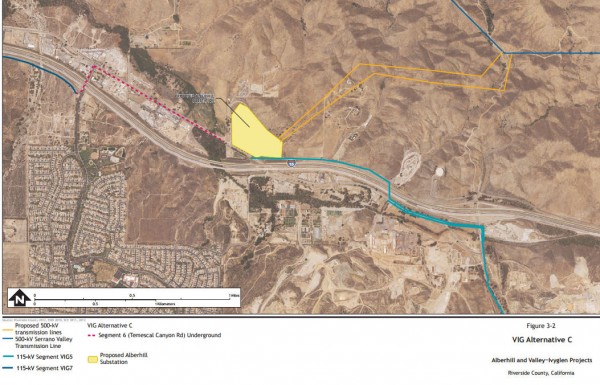 Instead of crossing to the west side of the I-15 from the proposed Alberhill substation, VIG Alternative C would keep the line on the east side of the freeway running underground along Temescal Canyon Road to Horsethief Canyon Road, turning west under the I-15 and rising above ground at De Palma Road.
Instead of crossing to the west side of the I-15 from the proposed Alberhill substation, VIG Alternative C would keep the line on the east side of the freeway running underground along Temescal Canyon Road to Horsethief Canyon Road, turning west under the I-15 and rising above ground at De Palma Road.
SUBSTATION ALTERNATIVES
There are two alternatives for the proposed Alberhill substation. ASP Alternative B would add all gas-insulated switchgear at the substation reducing several environmental impacts.
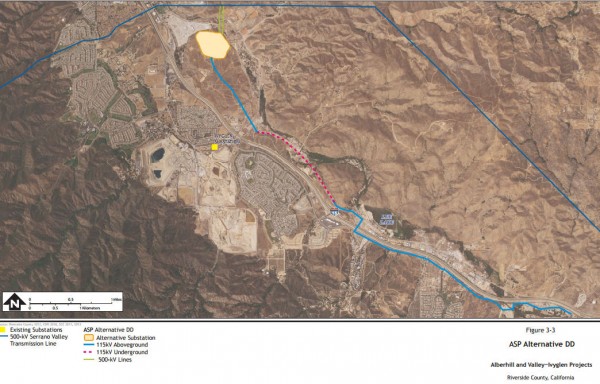 ASP Alternative DD relocates the substation to property within the Serrano Specific Plan. Approved by the county in 2010, the 489-acre Serrano Commerce Center is zoned for light industrial, commercial retail and open space. The property is on the east side of the I-15 and stretches from Temescal Canyon Road on the north to Temescal Canyon Road on the south adjacent to the freeway underpass. Development of the property never began and was further waylaid by the recession.
ASP Alternative DD relocates the substation to property within the Serrano Specific Plan. Approved by the county in 2010, the 489-acre Serrano Commerce Center is zoned for light industrial, commercial retail and open space. The property is on the east side of the I-15 and stretches from Temescal Canyon Road on the north to Temescal Canyon Road on the south adjacent to the freeway underpass. Development of the property never began and was further waylaid by the recession.
ASP Alternative DD would place the substation in the northern portion of the property adjacent to the former Rincor pipe plant.
The CPUC determined this alternative is aesthetically superior to the Alberhill proposal because it is not visible from the 1-15. It will be visible to Dawson Canyon, Spanish Hills and future Terramor residents. The CPUC notes that the substation’s location next to the Temescal Wash could be detrimental to this alternative, but views Serrano as being less impactful overall than Alberhill.
Unknown are the impacts the substation would have on requirements of the Serrano Specific Plan which call for hiking trails, a Temescal Valley Town Center in the plan’s commercial retail-zoned acreage and a secondary road to redirect truck traffic from the west side to the east side of the freeway.
SCE plans substation, power lines here
(Updated May 3, 2016)
The California Public Utilities Commission is now receiving comments on the final draft environmental impact report for Southern California Edison’s Valley-IvyGlen project and the proposed Alberhill substation.
The projects and their impacts will be explained at a meeting to be held in Lake Elsinore from 6 to 8 p.m., Wednesday, May 11 at the city’s Cultural Arts Center, 183 N. Main St. People attending the meeting will be able to comment on the projects.
VIEW THE DRAFT EIR
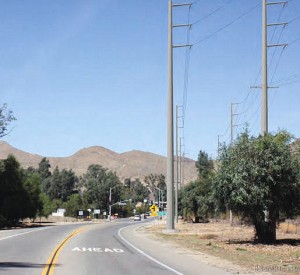
A simulated view of the transmission lines looking north on Lake Street near Temescal Canyon Road.
Deadline for all comments is May 31.
Comments can be emailed to: VIG.ASP@ene.com
Or mailed to:
California Public Utilities Commission
RE: VIG/ASP
c/o Ecology and Environment, Inc.
505 Sansome Street, Suite 300
San Francisco, CA 94111
Fax: (415) 398-5326
The Valley-IvyGlen project, which Edison began nine years ago, will span 27 miles and bring a backup power source to Temescal Valley – currently only one line serves local consumers. The project calls for above-ground, single-circuit 115-kV subtransmission lines to run from the Valley substation in Menifee through Perris and Lake Elsinore, and continue into Temescal Valley, running north along De Palma Road adjacent to Horsethief Canyon Ranch and Glen Eden Sun Club.
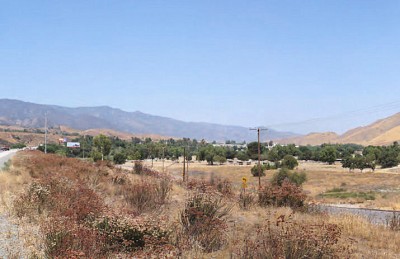
Current view from the northbound 1-15 looking toward Concordia Ranch Road.
The lines will cross to the east side of the 1-15 north of Glen Eden and continue along Temescal Canyon Road. They will be placed underground at about Indian Truck Trail, where they will continue to the IvyGlen substation on Temescal Canyon Road near Maitri Road.
The current 30- to 80-foot tall wooden poles will be replaced with 115-foot steel poles, plus additional steel poles will be added to the landscape.
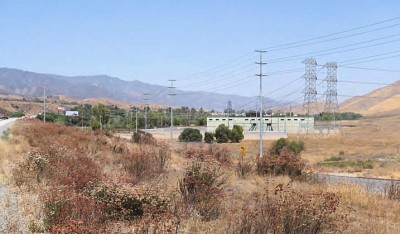
Simulated view after construction of the Alberhill substation.
The proposed 34-acre Alberhill substation will be constructed on 124 acres of land owned by Edison at the corner of Temescal Canyon and Concordia Ranch roads east of the 1-15.
The project calls for two 500-kV transmission lines to join the existing 500-kV Serrano-Valley transmission line near the Lake Mathews-Estelle Mountain Reserve in Temescal Valley.
Last May the CPUC held a scoping meeting to answer questions about the two projects and invite public comments for the draft EIR. There were a couple dozen people in attendance – 10 from Temescal Valley, the rest Lake Elsinore residents, and they voiced concerns about the projects’ significant impacts which had been noted by the CPUC. Most all said they wanted underground lines.
The draft EIR also includes possible alternatives to what is being proposed. The alternatives, in part, came from public comments the CPUC received last year during the scoping period. One alternative to the Valley-IvyGlen lines is VIG Alternative M that calls for the entire subtransmission line to be installed underground.
VIEW OTHER ALTERNATIVES HERE
Here are the significant impacts addressed in the draft EIR:
Significant Effects of the Alberhill Project
| Resource Area | Potential Effects |
| Aesthetics | A permanent effect on aesthetics along Interstate 15 (I-15), an eligible State Scenic Highway, could result from operation of the proposed Alberhill Project because the proposed Alberhill Substation, new 500-kV transmission lines, and new and upgraded 115-kV subtransmission lines (115-kV Segments ASP1, ASP3, ASP4, and ASP5) would be visible to motorists. Permanent effects may result because of visual contrast, alterations to existing scenic integrity, blocked or partially blocked views, and the introduction of industrial-like facilities to a relatively undeveloped rural area. The following components, among others, would be viewable from I-15:
|
| Permanent effects on the visual character or quality of a site or its surrounding area could result from operation of the proposed Alberhill Project at the proposed Alberhill Substation site, along the 500-kV transmission line routes, along 115-kV Segments ASP1 and ASP6, and along the northern section of the proposed 115-kV Segment ASP2 route near the proposed Alberhill Substation site that may reduce the intactness, unity, or vividness of existing views. | |
| Air Quality | Temporary violations of maximum daily on-site emission levels of fugitive dust (particulate matter of 10 micrometers or less [PM10] and 2.5 micrometers or less [PM2.5]) would occur during construction of the proposed Alberhill Substation due to grading, excavation, and asphalting. Temporary violations for maximum daily on-site emission levels of PM10 would occur during construction of the proposed 115-kV subtransmission lines from roadwork, site preparation, structure installation, and wire stringing. |
| The temporary exposure of sensitive receptors to substantial concentrations of volatile organic compounds (VOC) and fugitive dust (PM10 and PM2.5) would occur during construction of the proposed Alberhill Substation, 500-kV transmission lines, and 115-kV subtransmission lines. | |
| Biological Resources | Temporary, permanent, direct, and indirect effects on Stephens kangaroo rat would likely result from the construction and operation of the proposed Alberhill Substation, 500-kV lines, and several of the 115-kV segments. |
| Temporary, permanent, direct, and indirect effects on riparian areas and federally protected wetlands (e.g., Temescal Wash or its tributaries) as defined by Clean Water Act Section 404 could result from construction and operation activities along the proposed 500-kV and 115-kV routes and at proposed Alberhill Substation site. | |
| Hazards and Hazardous Materials | Each of the 560-MVA 500/115-kV transformers would contain approximately 33,550 gallons of transformer oil. In California, all used oil is managed as hazardous waste until tested to show it is not hazardous (Section 25250.4 of the California Health and Safety Code). Direct and indirect effects from the accidental release of hazardous materials could result during construction and operation of the proposed Alberhill Substation. |
| Temporary and permanent effects from fire could result from construction and operation of the proposed Alberhill Project along the proposed 500-kV and 115-kV lines and at the proposed Alberhill Substation site, which would be located within or adjacent to Very High Fire Hazard Severity Zones. | |
| Hydrology and Water Quality | Temporary, direct, and indirect effects on water quality and existing drainage patterns could result from construction of the proposed Alberhill Substation, access road to 500-kV Tower SA-5, and along sections of the proposed 115-kV segments due to project-related activities such as the placement of fill, earth moving activities, and the potential for spill of hazardous materials near jurisdictional (e.g., Temescal Wash ) and potentially jurisdictional waterways/drainages. |
| Cumulative Effects | Aesthetics. A permanent effect on aesthetics along an eligible State Scenic Highway (I-15) could result from operation of the proposed Alberhill Project in addition to the proposed TalegaEscondido/ValleySerrano (TE/VS) Project, and proposed ValleyIvyglen Project. The proposed Alberhill Substation, 500-kV transmission lines, and 115-kV Segments ASP1 through ASP5, as well as the proposed ValleyIvyglen Project 115-kV Segments VIG3 through VIG7 and proposed TE/VS switchyard and associated 500-kV transmission lines, would be visible from I-15. |
| Air Quality. A temporary violation of maximum daily on-site emission levels of PM10 and PM2.5 (fugitive dust) would occur during the construction of the proposed Alberhill System Project, proposed ValleyIvyglen Project, and proposed TE/VS Project. Construction activities that overlap (e.g., earth-moving activities) may result in cumulative effects on air quality. | |
| Air Quality. Construction of the proposed Alberhill System Project, proposed ValleyIvyglen Project, and proposed TE/VS Project could result in a temporary, cumulatively considerable net increase of VOC, nitrogen oxide, particulate matter of PM10, and PM2.5 due to diesel- and gasoline-fueled engine exhaust from vehicles and equipment. | |
| Biological Resources. Construction of the proposed Alberhill System Project, proposed ValleyIvyglen Project, and proposed TE/VS Project could result in cumulatively considerable effects on riparian areas and federally protected wetlands. |
Potentially Significant Effects of the Valley-Ivyglen Project
| Resource Area | Potential Effects |
| Aesthetics | Temporary and permanent effects on aesthetic resources along Interstate 15 (I-15) and State Route 74 (SR-74), both eligible State Scenic Highways, could result from construction and operation of the proposed ValleyIvyglen Project. Construction would occur over a 24-month period, and construction activities along 115-kV Segments VIG1 through 115-kV VIG8 would be noticeable to area residents and motorists along I-15 and SR-74. Construction activities that would temporarily affect scenic resources include:
A permanent effect on aesthetics along I-15 and SR-74 could result from the replacement of existing wood distribution line poles (30 to 80 feet tall) with new steel poles (up to 115 feet tall) and the introduction of new steel poles. The new poles would result in permanent visual contrast, alterations to existing scenic integrity, blocked or partially blocked views, and the introduction of industrial-like facilities to a relatively undeveloped rural area. The new and upgraded 115-kV subtransmission structures along 115-kV Segments VIG1 through 115-kV VIG8 would be intermittently noticeable to area residents and motorists along I-15 and SR-74. |
| Air Quality | Temporary violations for maximum daily on-site emission levels of PM10 would occur during construction of the proposed 115-kV subtransmission lines from roadwork, site preparation, structure installation, and wire stringing. |
| The temporary exposure of sensitive receptors to substantial concentrations of volatile organic compounds (VOC) and fugitive dust (particulate matter of 10 micrometers or less and particulate matter of 2.5 micrometers or less) would occur during construction of the proposed 115-kV subtransmission lines. | |
| Biological Resources | Temporary, permanent, direct, and indirect effects on Stephens kangaroo rat would likely result from construction of several of the proposed 115-kV segments. |
| Temporary, permanent, direct, and indirect effects on riparian areas and federally protected wetlands (e.g., Temescal Wash or its tributaries or the San Jacinto River) as defined by Clean Water Act Section 404 could result from construction and operation of a number of the proposed 115-kV segments. Among the areas likely to be affected are the proposed access roads and new structures along 115-kV Segment VIG6, trenched areas to install 115-kV Segment VIG8 underground, and the area where two tubular steel poles (4765121E and 4765120E) would be installed along 115-kV Segment VIG1 adjacent to the San Jacinto River. | |
| Hazards and Hazardous Materials | Temporary effects from the use of hazardous materials and petroleum products could result in upset or accident conditions involving the release of hazardous materials and petroleum products during construction. |
| Temporary and permanent effects from wildfire could result during construction and operation of the proposed ValleyIvyglen Project along proposed 115-kV segments that would be located within or adjacent to Very High Fire Hazard Severity Zones. | |
| Hydrology and Water Quality | Temporary and long-term effects on water quality and existing drainage patterns could result from 1) foundation excavation for 115-kV structure installations; 2) vegetation removal and earthmoving activities at construction sites and for access roads; 3) culvert construction across aquatic features; and 4) blasting. Erosion or siltation on or off site could result from the grading and vegetation clearing along a number of the proposed 115-kV Segments including along 115-kV Segment 8 where trenching would be required to install the proposed 115-kV line underground near Temescal Wash, a jurisdictional waterway. |
| Land Use | Potential conflict with Riverside County and City of Lake Elsinore land use policies, zoning ordinances, and requirements within specific plan areas could result (e.g., Alberhill Ridge Specific Plan in Lake Elsinore) because of the installation of new structures within 50 feet of eligible State Scenic Highways (Riverside County General Plan Policy 13.4), installation of structures along visually significant ridgelines and hilltops (Riverside County General Plan Policy 11.1(d)), or within an adopted road realignment for Lake Street (City of Lake Elsinore Vesting Tentative Tract No. 35001). |
| Noise | Temporary effects on nearby sensitive receptors could result from construction equipment and activities, including helicopter use and blasting that would exceed local noise standards, substantially increase temporary ambient noise levels, and generate substantial ground-borne vibrations during construction. |
| Traffic | Temporary effects on air traffic patterns could result from the use of helicopters during construction that increase safety risks. |
| Cumulative Effects | Cumulatively considerable effects may occur on aesthetics, air quality, and biological resources |

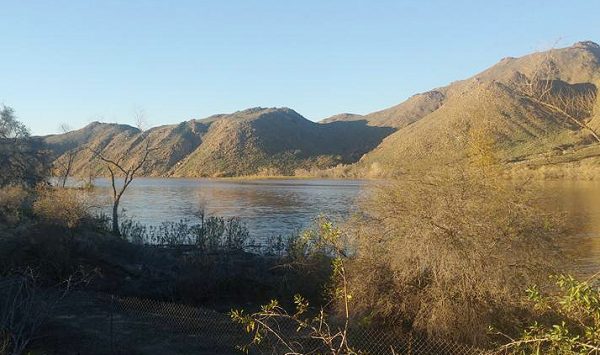 SITE OF FUTURE DEVELOPMENT: Lakeside Temescal Valley, if approved, would be a 370-home housing development built on 67 acres between Lee Lake and Temescal Canyon Road. Photo: John Lewison
SITE OF FUTURE DEVELOPMENT: Lakeside Temescal Valley, if approved, would be a 370-home housing development built on 67 acres between Lee Lake and Temescal Canyon Road. Photo: John Lewison